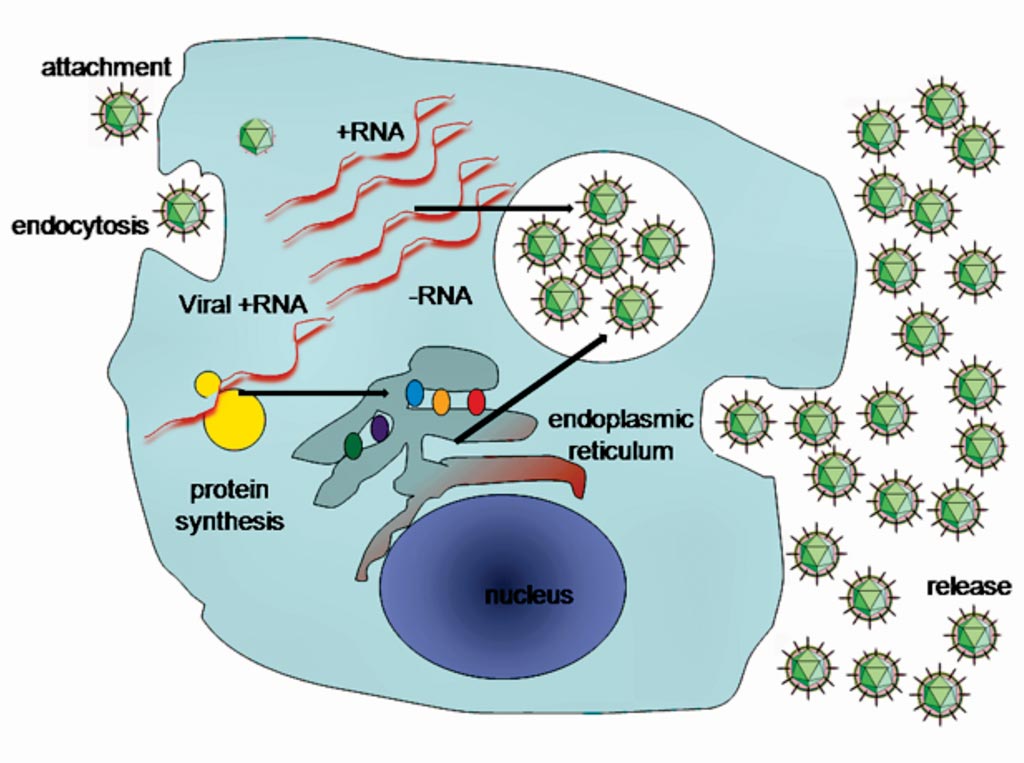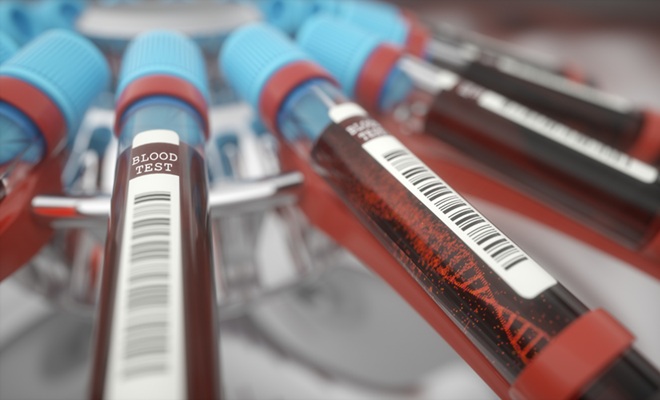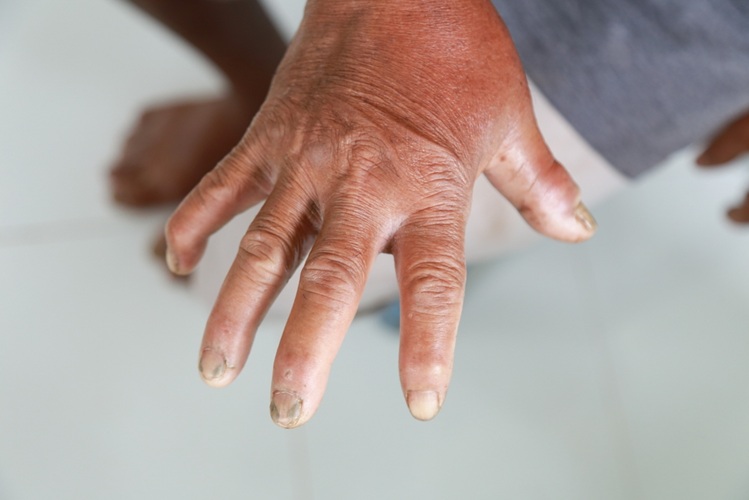HCV-RNA Present in Body Fluids in High Viral Load Patients
|
By LabMedica International staff writers Posted on 26 Dec 2018 |

Image: A simplified diagram of the Hepatitis C (HCV) replication cycle (Photo courtesy of Graham Malcolm Beards, DSc).
Hepatitis C virus (HCV) causes both acute and chronic infection. Acute HCV infection is usually asymptomatic, and is only very rarely (if ever) associated with life-threatening disease. About 15%–45% of infected persons spontaneously clear the virus within six months of infection without any treatment.
There is an ongoing epidemic of HCV) infection among men who have sex with men (MSM). Although epidemiological studies observed an association with certain sexual practices and/or concomitant recreational drug use, the underlying mechanisms of HCV transmission via these routes remains poorly defined.
Scientists at the Medical University of Vienna (Vienna, Austria) prospectively enrolled 34 Patients with acute (AHC) or chronic (CHC) HCV infection. Rectal and nasal swabs were obtained in all patients and after calibration and validation of the HCV assay, HCV-RNA levels were quantified in swab samples. Fecal occult blood tests were performed to rule out rectal bleeding. The mean age was 43 ± 8 years, the majority of patients (91%; 31/34) were HIV+ and 82% (28/34) were male of whom 64% (18/28) were MSM. Questionnaires were used to assess risk behavior related to recreational drug use and sexual practices.
AHC was observed in 32% (11/34) with all patients being HIV+MSM and 91% (10/11) having a history of sexually transmitted diseases. The most common HCV-genotype (GT) was GT-1a (50%; 17/34) whereas GT-1b, GT-2, GT-3 and GT-4 were observed in 15% (5/34), 3% (1/34), 21% (7/34) and 12% (4/34), respectively. Twenty-three (68%) patients had at least one positive swab sample (56%; 19/34 nasal and 52%; 17/33 rectal), whereas blood contamination was never detected. Individuals with positive swab sample had significantly higher HCV-RNA viremia versus patients with negative swab sample (6.37 IQR 1.06 log IU/mL versus 4.76 IQR 2.54 log IU/mL.
The authors concluded that HCV-RNA is readily detectable in rectal (despite the absence of fecal occult blood) and nasal fluids in patients with AHC/CHC, independently of HIV status, duration of HCV infection or the suspected route of HCV acquisition. Thus, the data strongly suggest that sharing of nasal drug-sniffing 'tools' and unprotected anal intercourse represent high-risk practices for HCV transmission, especially in patients with high serum HCV-RNA levels.
David Chromy, MD, the lead author of the study, said, “We actually did expect to find HCV RNA in the body fluids of our patients. Still we aimed to carefully rule out contamination of rectal fluid by occult bleeding (as a potential confounder) by performing a respective test for occult fecal blood. These bodily fluids may serve as vectors for transmission, still we strongly believe that additional mucosal trauma and/or bleeding is necessary for transmitting HCV-RNA and thus, HCV infection.” The study was presented at the American Association for the Study of Liver Diseases (AASLD; Liver Meeting) in held November 9-13, 2018, in San Francisco, CA, USA.
Related Links:
Medical University of Vienna
There is an ongoing epidemic of HCV) infection among men who have sex with men (MSM). Although epidemiological studies observed an association with certain sexual practices and/or concomitant recreational drug use, the underlying mechanisms of HCV transmission via these routes remains poorly defined.
Scientists at the Medical University of Vienna (Vienna, Austria) prospectively enrolled 34 Patients with acute (AHC) or chronic (CHC) HCV infection. Rectal and nasal swabs were obtained in all patients and after calibration and validation of the HCV assay, HCV-RNA levels were quantified in swab samples. Fecal occult blood tests were performed to rule out rectal bleeding. The mean age was 43 ± 8 years, the majority of patients (91%; 31/34) were HIV+ and 82% (28/34) were male of whom 64% (18/28) were MSM. Questionnaires were used to assess risk behavior related to recreational drug use and sexual practices.
AHC was observed in 32% (11/34) with all patients being HIV+MSM and 91% (10/11) having a history of sexually transmitted diseases. The most common HCV-genotype (GT) was GT-1a (50%; 17/34) whereas GT-1b, GT-2, GT-3 and GT-4 were observed in 15% (5/34), 3% (1/34), 21% (7/34) and 12% (4/34), respectively. Twenty-three (68%) patients had at least one positive swab sample (56%; 19/34 nasal and 52%; 17/33 rectal), whereas blood contamination was never detected. Individuals with positive swab sample had significantly higher HCV-RNA viremia versus patients with negative swab sample (6.37 IQR 1.06 log IU/mL versus 4.76 IQR 2.54 log IU/mL.
The authors concluded that HCV-RNA is readily detectable in rectal (despite the absence of fecal occult blood) and nasal fluids in patients with AHC/CHC, independently of HIV status, duration of HCV infection or the suspected route of HCV acquisition. Thus, the data strongly suggest that sharing of nasal drug-sniffing 'tools' and unprotected anal intercourse represent high-risk practices for HCV transmission, especially in patients with high serum HCV-RNA levels.
David Chromy, MD, the lead author of the study, said, “We actually did expect to find HCV RNA in the body fluids of our patients. Still we aimed to carefully rule out contamination of rectal fluid by occult bleeding (as a potential confounder) by performing a respective test for occult fecal blood. These bodily fluids may serve as vectors for transmission, still we strongly believe that additional mucosal trauma and/or bleeding is necessary for transmitting HCV-RNA and thus, HCV infection.” The study was presented at the American Association for the Study of Liver Diseases (AASLD; Liver Meeting) in held November 9-13, 2018, in San Francisco, CA, USA.
Related Links:
Medical University of Vienna
Latest Microbiology News
- Handheld Device Delivers Low-Cost TB Results in Less Than One Hour
- New AI-Based Method Improves Diagnosis of Drug-Resistant Infections
- Breakthrough Diagnostic Technology Identifies Bacterial Infections with Almost 100% Accuracy within Three Hours
- Innovative ID/AST System to Help Diagnose Infectious Diseases and Combat AMR
- Gastrointestinal Panel Delivers Rapid Detection of Five Common Bacterial Pathogens for Outpatient Use
- Rapid PCR Testing in ICU Improves Antibiotic Stewardship
- Unique Genetic Signature Predicts Drug Resistance in Bacteria
- Unique Barcoding System Tracks Pneumonia-Causing Bacteria as They Infect Blood Stream
- Rapid Sepsis Diagnostic Test Demonstrates Improved Patient Care and Cost Savings in Hospital Application
- Rapid Diagnostic System to Detect Neonatal Sepsis Within Hours
- Novel Test to Diagnose Bacterial Pneumonia Directly from Whole Blood
- Interferon-γ Release Assay Effective in Patients with COPD Complicated with Pulmonary Tuberculosis
- New Point of Care Tests to Help Reduce Overuse of Antibiotics
- 30-Minute Sepsis Test Differentiates Bacterial Infections, Viral Infections, and Noninfectious Disease
- CRISPR-TB Blood Test to Enable Early Disease Diagnosis and Public Screening
- Syndromic Panel Provides Fast Answers for Outpatient Diagnosis of Gastrointestinal Conditions
Channels
Clinical Chemistry
view channel
New Method Uses Pulsed Infrared Light to Find Cancer's 'Fingerprints' In Blood Plasma
Cancer diagnoses have traditionally relied on invasive or time-consuming procedures like tissue biopsies. Now, new research published in ACS Central Science introduces a method that utilizes pulsed infrared... Read more
Carbon Nanotubes Help Build Highly Accurate Sensors for Continuous Health Monitoring
Current sensors can measure various health indicators, such as blood glucose levels, in the body. However, there is a need to develop more accurate and sensitive sensor materials that can detect lower... Read moreMolecular Diagnostics
view channel
Gene-Based Blood Test Accurately Predicts Tumor Recurrence of Advanced Skin Cancer
Melanoma, an aggressive form of skin cancer, becomes extremely difficult to treat once it spreads to other parts of the body. For patients with metastatic melanoma tumors that cannot be surgically removed... Read more
Blood Test Could Identify Patients at Risk for Severe Scleroderma
Systemic sclerosis, also known as scleroderma, causes the hardening of the skin and connective tissues. In many cases, the disease can also damage vital organs, including the heart, kidneys, lungs, and... Read moreHematology
view channel
New Scoring System Predicts Risk of Developing Cancer from Common Blood Disorder
Clonal cytopenia of undetermined significance (CCUS) is a blood disorder commonly found in older adults, characterized by mutations in blood cells and a low blood count, but without any obvious cause or... Read more
Non-Invasive Prenatal Test for Fetal RhD Status Demonstrates 100% Accuracy
In the United States, approximately 15% of pregnant individuals are RhD-negative. However, in about 40% of these cases, the fetus is also RhD-negative, making the administration of RhoGAM unnecessary.... Read moreImmunology
view channel
Stem Cell Test Predicts Treatment Outcome for Patients with Platinum-Resistant Ovarian Cancer
Epithelial ovarian cancer frequently responds to chemotherapy initially, but eventually, the tumor develops resistance to the therapy, leading to regrowth. This resistance is partially due to the activation... Read more
Machine Learning-Enabled Blood Test Predicts Immunotherapy Response in Lymphoma Patients
Chimeric antigen receptor (CAR) T-cell therapy has emerged as one of the most promising recent developments in the treatment of blood cancers. However, over half of non-Hodgkin lymphoma (NHL) patients... Read morePathology
view channel
New Error-Corrected Method to Help Detect Cancer from Blood Samples Alone
"Liquid biopsy" technology, which relies on blood tests for early cancer detection and monitoring cancer burden in patients, has the potential to transform cancer care. However, detecting the mutational... Read more
"Metal Detector" Algorithm Hunts Down Vulnerable Tumors
Scientists have developed an algorithm capable of functioning as a "metal detector" to identify vulnerable tumors, marking a significant advancement in personalized cancer treatment. This breakthrough... Read more
Novel Technique Uses ‘Sugar’ Signatures to Identify and Classify Pancreatic Cancer Cell Subtypes
Pancreatic cancer is often asymptomatic in its early stages, making it difficult to detect until it has progressed. Consequently, only 15% of pancreatic cancers are diagnosed early enough to allow for... Read moreTechnology
view channel
Pain-On-A-Chip Microfluidic Device Determines Types of Chronic Pain from Blood Samples
Chronic pain is a widespread condition that remains difficult to manage, and existing clinical methods for its treatment rely largely on self-reporting, which can be subjective and especially problematic... Read more
Innovative, Label-Free Ratiometric Fluorosensor Enables More Sensitive Viral RNA Detection
Viruses present a major global health risk, as demonstrated by recent pandemics, making early detection and identification essential for preventing new outbreaks. While traditional detection methods are... Read moreIndustry
view channel
Cepheid and Oxford Nanopore Technologies Partner on Advancing Automated Sequencing-Based Solutions
Cepheid (Sunnyvale, CA, USA), a leading molecular diagnostics company, and Oxford Nanopore Technologies (Oxford, UK), the company behind a new generation of sequencing-based molecular analysis technologies,... Read more
Grifols and Tecan’s IBL Collaborate on Advanced Biomarker Panels
Grifols (Barcelona, Spain), one of the world’s leading producers of plasma-derived medicines and innovative diagnostic solutions, is expanding its offer in clinical diagnostics through a strategic partnership... Read more























